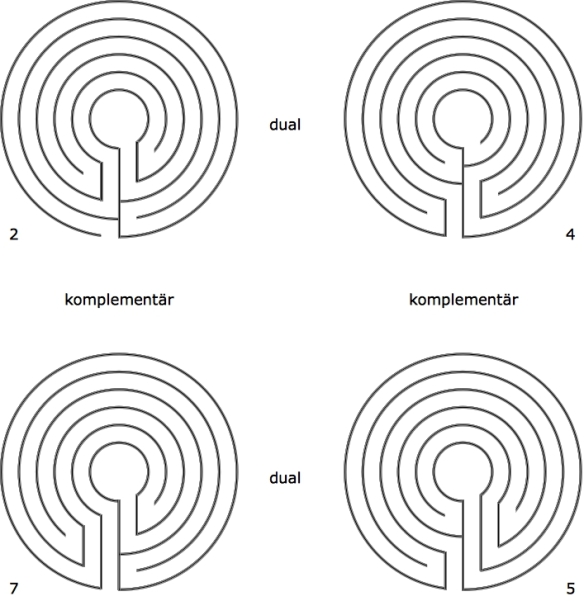In the last post I have presented the complementary labyrinth. I did this with the example of the basic type labyrinth. This is a self-dual labyrinth. The complementary is different from the dual labyrinth. This can be better shown using non-self-dual labyrinths. I want tho show this here and for this choose an alternating labyrinth with 1 arm and 5 circuits. As already shown in this blog, there exist 8 such labyrinths (see related post below: Considerung Meanders and Labyrinths). Of these, 4 are self-dual (labyrinths 1, 3, 6, and 8) and 4 are not self-dual (labyrinths 2, 4, 5, and 7).
I thus choose one of the non-self-dual labyrinths, nr. 2, and use the pattern of it. With the pattern, two activities can be performed:
Figure 1 shows the result of performing these actions with pattern 2.
Rotation leads to the pattern of labyrinth 4
Mirroring leads to pattern 7
So we have already three labyrinths. Now it is possible to go even further. Rotating the dual again brings it back to the original labyrinth. However, the dual can also be mirrored. This results then in the complementary of the dual. And similarly, the complementary can be rotated, which results in the dual to the complementary.
Mirroring of the dual (pattern 4) leads to the complementary pattern of labyrinth 5
Rotation of the complementary (pattern 7) leads to the dual of it – which is also pattern 5.
Figure 2 shows the labyrinths corresponding to the patterns. The labyrinths are presented in basic form (i.e shown with their walls delimiting the pathway) in the concentric style. All four non-self-dual alternating labyrinths with 1 arm and 5 circuits are in a relation of either dualtiy or complementarity to each other.
Related posts:



Pingback: The Related Labyrinths | blogmymaze
Pingback: The Complementary Classical 7 Circuit Labyrinth | blogmymaze
Thank you for your very informative and interesting comments and references to the group theory. I must confess, I havn’t known this theory before. So it seems we have two slightly different approaches that, overall, lead to the same result. If we start both from the same labyrinth, you then, say, directly (horizontally or vertically) proceed to the dual (180° rotation, vertical and horizontal reflection of the level chart), and to the “transpose” (vertical reflection of the level chart with flipping entrance and exit connections). I proceed directly to the dual also but second to the “complementary” (horizontal reflection of the level chart with flipping entrance and exit connections). The “complementary” thus is dual to your “transpose”. So in your representation of the four members of a sub family, the labyrinth diagonal to the base labyrith is the dual to the “transpose”, i.e. my “complementary”, whereas in my representation it is the dual to the “complementary” i.e. the “transpose”.
LikeLike
Yes, that’s exactly right. You can label the “transform diagram” with any two of r, t, c on the perimeter edges (putting the same letter on opposite sides) and then using the remaining third letter on the two diagonals. I prefer to use r and t as the “primitive actions” on the perimeter since “self-dual” and “self-transpose” are useful concepts, while “self-complementary” applies only to the 1-course labyrinth.
LikeLike
Thus, the operation c corresponds to the diagonals in my Caerdroia diagram, and t corresponds to the diagonals in your diagram above.
LikeLike
Similarly, the transpose operator t also appears as the 4th corner in your diagram above: labyrinth 5 is cr applied to the original labyrinth, which is the same as t applied to the original. t is defined by taking the mirror image side-to-side and then flipping the exit and entrance connections around. You could also define the complementation operator c as taking the mirror image front-back and then flipping the exit and entrance connections around.
LikeLike
The complementation operator (call it c) is the fourth corner in Figure 10 (p. 51) of my article “Wayland’s New Labyrinths” in Caerdroia 44 (2015). I.e., if t is the transpose operator, and r the 180-degree rotation operator (the dual operator), then c = tr = rt. These three plus the identity operator e form a 4-element group isomorphic to the Klein 4-group = Z2 x Z2. Each operator is idempotent (applying it twice gets you back to the original): tt = e, cc = e, rr = e, ee = e. Any two of t, c, r generates the full group. Thus t = cr = rc and r = tc = ct.
LikeLike
Pingback: The Relatives of the Labyrinth Type Gossembrot 51 r | blogmymaze
Pingback: The Relatives of the Ravenna-type Labyrinth | blogmymaze
Pingback: Variations on the Babylonian Visceral Labyrinths in Knidos Style | blogmymaze
Pingback: Sequences of Circuits in Dual and Complementary Labyrinths | blogmymaze
Pingback: Complementary and Self-dual Labyrinths | blogmymaze